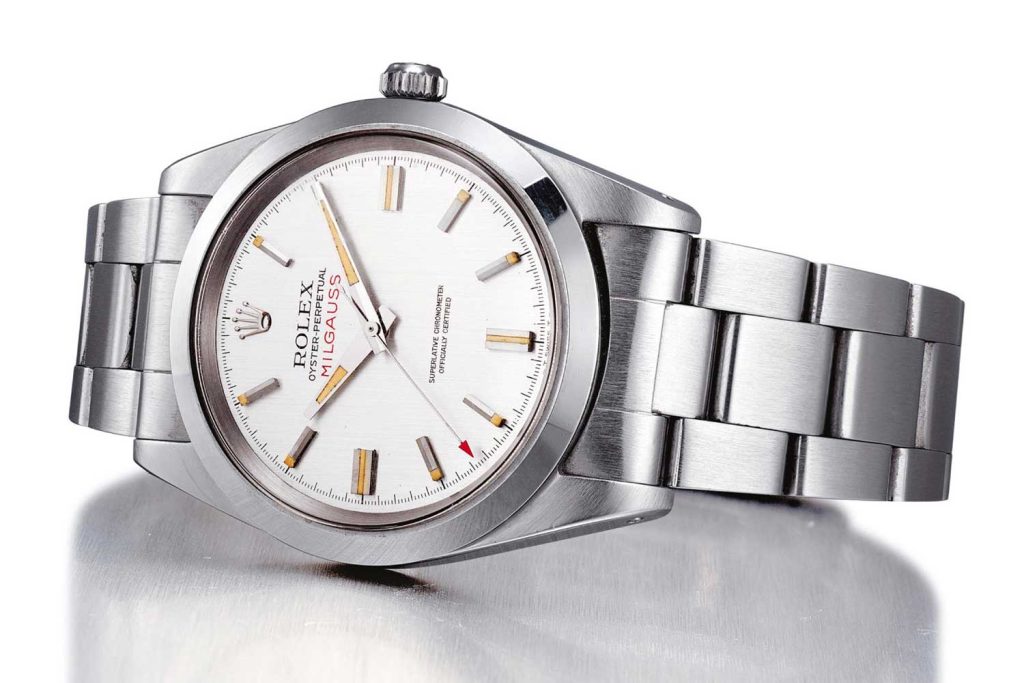Rolex Milgauss: The Ultimate Guide to the Anti-Magnetic Icon
Introduction to a Scientific Marvel
Among luxury watches, few timepieces stand out for their unique heritage and specialized purpose like the Rolex Milgauss. Designed in 1956, this model was created with a singular mission: to withstand strong magnetic fields that often disrupt the accuracy of mechanical watches. While most luxury watches emphasize prestige, style, or complications, this model emerged as a technical solution for professionals working in laboratories, power plants, and medical facilities. Over the decades, it has gained a cult following, not just for its scientific roots but also for its distinct design and role as a trailblazer in horological innovation.
The Birth of an Anti-Magnetic Icon
The 1950s was a period of rapid scientific progress, with nuclear research, electronics, and industrial advancements reshaping industries. This environment gave rise to the need for a wristwatch that could remain precise despite exposure to strong magnetic interference. Traditional mechanical movements often became unreliable around high levels of magnetism, leading Rolex to develop an innovative watch that could resist up to 1,000 gauss — hence the name “Milgauss.” By encasing the movement in a protective magnetic shield, the watch became an essential tool for Rolex Milgauss engineers and researchers. Its very existence reflected Rolex’s commitment to solving real-world problems through craftsmanship.
A Watch Made for Scientists
Unlike diving watches built for underwater exploration or pilot watches tailored to aviation, the Rolex Milgauss found its niche in scientific fields. It became a companion for researchers at CERN, the European Organization for Nuclear Research, where magnetic environments were part of daily life. The ability to resist magnetism without compromising accuracy made it revolutionary. For professionals who needed reliability in highly technical environments, it wasn’t just a timepiece — it was a necessity. This practical foundation remains at the heart of its identity today, even as it has become a luxury symbol in modern markets.
Design and Aesthetic Uniqueness
While functionality defined its purpose, the Rolex Milgauss also stood out with a bold design language. One of its most recognizable features is the orange lightning-bolt-shaped seconds hand, symbolizing both electricity and scientific discovery. The watch also introduced striking color variations, such as the vibrant green-tinted sapphire crystal, which was groundbreaking in luxury watchmaking. These Rolex Milgauss design cues gave it a personality that set it apart from Rolex’s more conservative models like the Datejust or Day-Date. Its mix of scientific seriousness and playful details created an identity that appealed to both professionals and collectors alike.
Table of Contents
The Evolution Through Generations
The journey of this watch is marked by innovation and refinement. The earliest reference, the 6541, was produced in the late 1950s and bore strong similarities to the Submariner, with a rotating bezel and robust case. Later iterations, such as the reference 1019, simplified the design by removing the bezel and opting for a clean, minimalist dial. After being discontinued in the late 1980s, the model made a celebrated comeback in 2007 with the reference 116400, which reintroduced the lightning-bolt seconds hand and introduced modern materials. The inclusion of green sapphire crystal in later releases became a hallmark of the contemporary Milgauss, cementing its place as a distinctive and collectible piece.
Engineering Excellence
Beyond its aesthetics, the Rolex Milgauss remains a feat of engineering. Its resistance to magnetism is achieved through a combination of materials and design elements. The movement is encased in a soft iron Faraday cage, which deflects magnetic interference. Additionally, Rolex has incorporated paramagnetic components into the movement itself, further enhancing resilience. The Caliber 3131, used in modern versions, exemplifies precision, reliability, and durability — qualities synonymous with the brand. These technical innovations ensure that the watch is not merely a statement piece but a reliable tool even under extreme conditions.
Collectability and Market Value
Over time, the Rolex Milgauss has transitioned from a specialized scientific tool to a coveted collector’s item. Vintage models, particularly the early references, are highly sought after by enthusiasts for their rarity and historical significance. The green crystal editions released in the 2000s also enjoy strong demand due to their distinctive appearance. Unlike other Rolex models primarily valued for association with sports or celebrities, this watch draws appeal from its niche origins and unique engineering purpose. Collectors see it as both an underappreciated gem and a statement of individuality within the broader Rolex lineup.
Why the Milgauss Stands Apart
What sets the Rolex Milgauss apart from other watches is not only its technical resistance to magnetism but also its balance of function and flair. It is equally at home in a laboratory as it is in a boardroom. Unlike more mainstream Rolex models, it carries an air of exclusivity rooted in its specialized history. The design elements, such as the colored dials and distinctive crystal, enhance its personality, making it ideal for those who want a luxury watch that feels different. In a world where many timepieces are judged by celebrity endorsements or flashy complications, this one maintains an understated prestige grounded in scientific innovation.
The Role of Innovation in Identity
Rolex has always been a brand associated with innovation, from pioneering waterproof Oyster cases to self-winding mechanisms. The Milgauss embodies this spirit by showcasing how the brand addresses unique professional needs while still delivering luxury appeal. Its ability to evolve while staying true to its scientific origins demonstrates Rolex’s foresight. Even as technology has advanced and magnetism-resistant materials are more common, the watch still symbolizes the pioneering approach that set it apart in the 1950s.
Conclusion: A Legacy of Precision and Style
The Rolex Milgauss is more than just a luxury wristwatch; it is a testament to the intersection of science, engineering, and design. Created for scientists, it broke boundaries by solving a practical problem that had challenged watchmakers for decades. Over time, it has matured into a symbol of individuality and technical excellence, admired by both professionals and collectors. With its bold lightning-bolt seconds hand, vibrant crystal, and unmatched anti-magnetic capabilities, it continues to embody the spirit of progress and precision. For anyone looking to own a timepiece that combines history, innovation, and style, the Milgauss remains an unmatched choice.







